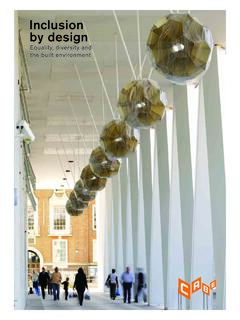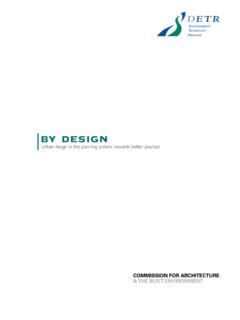Transcription of This way to better streets: 10 case ... - Design Council
1 Briefing This way to better streets: 10 case studies on improving street Design Streets are hard-working spaces. They balance a wide range of uses, communicate values and signify the transformation of neighbourhoods, towns and cities. To be sustainable and fit for purpose in the 21st century, streets need to respond to the demands of climate change and shifts in culture. CABE has reviewed 10 streets, looking at Design development and implementation to unlock the lessons learnt. They provide an insight into recent developments in street Design . This briefing summarises the findings. Details of the 10 case studies can be found at Background Street Design policies, formalised in the 1960s through reports such as Buchanan's Traffic in towns1, sought to simplify and organise streets through segregation. The result is that too many streets are designed for traffic movement alone, dominated by traffic signs, with people herded behind guard rails into pinch points to cross the road.
2 We know that streets are far more than the tarmac between pavements, but that is where priority has been focused. However, change is around the corner. Manual for streets 2, new government guidance, recognises the wider role of streets in creating successful places. It acknowledges that streets need to respond to the complexities of public life, promoting the interaction of people with different priorities, different circumstances and different expectations. It emphasises an interdisciplinary approach, innovation and flexibility, and the need for a better balance between pedestrians and vehicles in the Design of residential and lightly trafficked streets. It also states that these principles could equally be applied to other urban streets. Growing awareness of the importance of risk in public space has important implications for street Design . The complex and unpredictable outcomes of removing barriers illustrate how reconsidering long-standing assumptions about safety and behaviour can provide opportunities for high quality streets3.
3 However, research for the case studies indicates that the role of highway engineers and the scope of the legal and regulatory framework remain widely misunderstood. CABE's 2006 progress report on improving the quality of streets and public spaces, Transforming our streets 4, drew attention to the continuing need to overcome widespread confusion about risk, innovation, liability and the use of processes such as safety auditing. A 2007 research report, Living with risk 5, evaluates the impact of risk on the Design of 10. public spaces and sets out an agenda for public space Design that is risk aware, not risk-averse. The Manual for streets provides clarification of liability and street Design . It proposes a quality audit to help integrate many of the fragmented processes involved in delivering streets. 1 Buchanan, C., Traffic in towns, 1963. 2 Department for Transport, Manual for streets, 2007. 3 Royal Borough of Kensington and Chelsea, Report on road safety in Kensington High Street, 2006.
4 4 CABE, Transforming our streets, 2006. 5 CABE, Living with risk: promoting better public space Design , 2007. 2. The case studies A. B. Bideford Quay, Devon Temple Meads Station forecourt, Bristol The 10 case studies featured in this briefing C Devizes Market Square, and in much more depth on CABE's website Wiltshire D O'Connell Street, Dublin (at ) help us to identify E Newhall Phase 1, the five key principles behind successful streets: I Harlow, Essex F Kensington High Street, West London 1 Vision D GH G Hope Street, Liverpool 2 Commitment J H Ancoats and New 3 Integration Islington, Manchester I Blackett Street, Side, and 4 Adaptation BC. E. Sandhill, Newcastle F. 5 Coherence A J Maid Marian Way, Nottingham Case study Context Lesson Bideford Quay, Devon A waterfront street in Take climate action a seaside town Temple Meads Station A transport interchange Provide continuity of quality forecourt, Bristol approach and forecourt skills and resources Devizes Market Square, An historic market town centre Be prepared for the long haul Wiltshire with bus interchange O'Connell Street, Dublin A major urban boulevard Select visual simplicity of national significance Newhall Phase 1, Harlow, Essex A new community and network Balance stakeholder of residential streets needs and interests Kensington High Street, A busy urban high street Achieve organisational West London and arterial route confidence Hope Street.
5 Liverpool An iconic street of Connect with place and history cultural significance Ancoats and New A network of streets as part of the Challenge long-held Islington, Manchester regeneration of an urban village assumptions Blackett Street, Side, and A network of historic streets to Integrate slower Design speeds Sandhill, Newcastle serve a busy bus network Maid Marian Way, Nottingham A repaired inner-city ring road Establish frameworks with at-grade crossings for communications 3. 1. Vision Connect with place and history Maintain a strong physical and Streets serve as statements of our collective values and culture. All of CABE's case studies organisational vision. Solve demonstrate an increasing understanding of the problems within that framework, emotional and psychological importance of streets, adapting structures and service and the relevance of such qualities to social safety, delivery accordingly.
6 Well-being and the promotion of civility. The issue of tree replacement is one specific example where change and renewal can prove particularly painful Be confident as an organisation and unpopular, calling for imaginative processes Good street Design requires the co-operation and public engagement to recognise the emotional and integration of a wide range of professional as well as practical issues surrounding change. disciplines, user groups and local authority Streets should promote the character of place by directorates. successful street projects can responding to and reinforcing locally distinctive provide a remarkable boost to the confidence and patterns of development, landscape and culture. organisational coherence of the local authorities The integration of creative artists into the Design involved. This is particularly the case when schemes teams at the outset characterises almost all of the challenge conventions and require unusual working selected case studies.
7 Some streets provide a relationships. The widespread confusion about perfect public gallery for monumental art, either risk, liability and the role of processes such as permanent or temporary. Others incorporate quirky safety auditing often constrain fresh thinking. To details to intrigue and delight at a scale that suits deal with risk a clear Design vision for a scheme, children or to civilise residential streets or simply supported by strong Design leadership is to reinforce connections with place and history. Kensington High Street works well as both a distinctive landmark and public space while also serving as a successful urban highway. This is a tribute to a combination of dedicated designers, progressive local authority officers and clear-sighted and determined political leadership. David Moores and Geoff Bray of the Project Centre never anticipated that the scheme would become such a significant and well-known icon of good street Design when they started work in 2000 (both pictured with Peter Weeden, Royal Borough of Kensington and Chelsea).
8 Some streets assume a symbolic and iconic significance well beyond their function as spaces for movement and public interaction. In Liverpool, Hope Street serves the city's famous landmarks and cultural institutions, including the city's two great Protestant and Catholic cathedrals. 6 CABE, Living with risk: promoting better public space Design , 2007. 4. Challenge long-held assumptions Establish frameworks for clear, creative Streets and public spaces are hugely important as communication drivers of economic and social regeneration. Fresh Adapting or renewing existing streets can be hugely ideas and challenges to long-held assumptions were disruptive. Most streets have to remain in use during evident in all the schemes. This suggests a much construction, and it is much harder to contain the needed renaissance in the Design , management and works or shield the public from the inconvenience leadership qualities necessary to deliver great streets.
9 Involved in construction. Establishing frameworks for Streets can serve as important statements of intent, public involvement and sharing information requires helping to raise aspirations and demonstrate potential considerable creativity and resources. Handled well, standards and quality. Such benefits can have street Design can provide opportunities for community wider value even when the physical measures engagement, particularly to promote interest amongst involved in schemes are short lived and children, who are often excluded despite the critical may need evolutionary changes. importance of streets to their lives and well-being. Some of the case studies highlight the extent to which imaginative and creative structures for discussion and communication can promote good Design solutions. Nottingham City Council Old Mill Street in New Islington, Manchester, represents a Nottingham City Council used good public relations throughout vision for a 21st century urban street, and its striking Design is difficult logistical site operations for the transformation of Maid the centrepiece of efforts to raise hope and confidence in this Marian Way.
10 Communication and consultation with the general public rapidly changing former industrial area. The tight urban grid involved imaginative measures; for instance, where the planting of of Ancoats presents a particular challenge to developers and trees had to wait until the planting season, the word tree' appeared the Urban Village Company to evolve an approach to streets across the temporary paving. An imaginative series of handouts that matches the robust Victorian architecture and sets a new kept the public informed and a programme of art works and events standard for integrating traffic with urban Design . celebrated the new pedestrian connection. 5. 2. Commitment Plan for high-quality skills and materials The benefits of simple, durable materials, capable Be committed to long delivery of withstanding the impact of heavy loads and timescales and to management and continuous activity, were evident in many case maintenance after delivery.


















